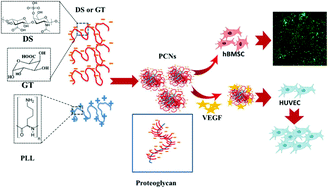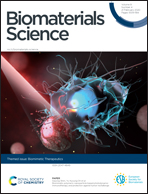Biomimetic proteoglycan nanoparticles for growth factor immobilization and delivery†
Abstract
The delivery of growth factors is often challenging due to their short half-life, low stability, and rapid deactivation. In native tissues, the sulfated residual of glycosaminoglycan (GAG) polymer chains of proteoglycans immobilizes growth factors through the proteoglycans'/proteins' complexation with nanoscale organization. These biological assemblies can influence growth factor–cell surface receptor interactions, cell differentiation, cell–cell signaling, and mechanical properties of the tissues. Here, we introduce a facile procedure to prepare novel biomimetic proteoglycan nanocarriers, based on naturally derived polymers, for the immobilization and controlled release of growth factors. We developed polyelectrolyte complex nanoparticles (PCNs) as growth factor nanocarriers, which mimic the dimensions, chemical composition, and growth factor immobilization of proteoglycans in native tissues. PCNs were prepared by a polymer–polymer pair reaction method and characterized for physicochemical properties. Fourier transform infrared spectroscopy (FTIR) analysis indicated that complexation occurred through electrostatic interactions. Transmission electron microscopy (TEM) results showed that the nanocarriers had a diameter of 60 ± 11 nm and 91 ± 33 nm for dermatan sulfate sodium salt–poly-L-lysine (DS-PLL) and gum tragacanth–poly-L-lysine (GT-PLL) complexes, respectively. The colloidal nanoparticles were stable due to their negative zeta potential, i.e. −25 ± 4 mV for DS-PLL and −18 ± 3.5 mV for GT-PLL. Cytocompatibility of PCNs in contact with human bone marrow stromal cells (HS-5) was confirmed through a live/dead assay and metabolic activity measurement. In addition, vascular endothelial growth factor (VEGF) was used to evaluate the ability of PCNs to stabilize growth factors. The capability of PCNs to preserve VEGF activity for up to 21 days was confirmed by analyzing the metabolic and mitogenic characteristics of human umbilical vein endothelial cells (HUVECs). Our results demonstrated the potential applications of these nanoparticles in therapeutic delivery for tissue regeneration applications.

- This article is part of the themed collections: Biomimetic Therapeutics and Biomaterials Science Lectureship Winners


 Please wait while we load your content...
Please wait while we load your content...